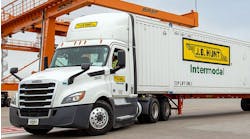INDIANAPOLIS. Buyers of used Class 8 trucks and the trailers that go with them should expect inventories to remain low and prices to stay high – even increase in some cases – until 2014 or 2015 at the earliest, according to Steve Clough, president of Arrow Truck Sales.
Speaking here at the 7th annual FTR Transportation Conference, held by industry research firm FTR Associates, Clough noted that prices have increased for used Class 8s significantly over the past two years, rising 11% from the fourth quarter of 2009 to August 2011 and then spiking another 19% from June through December 2010.
And while prices stayed flat in the traditional sense between December 2010 and August 2011, Clough stressed that overlooks the traditional one-year “discount” that occurs as a truck ages.
“Typically, a specific model loses 10 to 12% of its value – some $4,000 to $6,000 – each year it ages,” he explained. “The fact that pricing stayed even through August this year really translates into a further 10 to 12% jump in price.”
Clough noted that supply for used Class 8s as well as freight trailers – especially refrigerated units – will remain tight for at least three to four more years because production for both types of equipment fell off so dramatically during the recession.
“The supply of new trucks today, for example, comes from what was built three or four years ago,” he said – meaning the 151,000 Class 8s built in the U.S. in 2007 and 133,000 units built in 2008 are feeding today’s used truck inventory. Supplies will get even tighter as only 97,000 Class 8s were built in 2009, followed by 107,000 in 2010, Clough said.
“This means the extremes in the used-truck market are going to get more severe, in terms of scarce volume and high prices, until we start getting back to more normalized truck builds,” he explained.
An even worse situation faces the used-trailer market, as only 79,000 units were built in 2008, with 78,000 built in 2009 and 121,000 in 2010. That’s completely altered Arrow’s approach to this market, Clough noted.
“Two years ago, you could easily go out and buy a group of 20 good used trailers with the right specs customers were looking for,” he said. “Today, once we find even a smaller group of trailers in good condition with the right specs, we’ll get them right there – even if we don’t have a buyer for them – because we might not see such equipment for a month. We’ve never had to keep used trailer stock on hand before, but that’s what it’s come to because supply is so scarce.”


